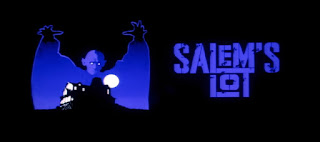1979 flick "Salem's Lot" seems to have been a watershed moment in many a horror fan's experience. Stephen King's name was already turning into a trademark, and the reputation of horror as a genre in marketable media was beginning to grow. That year in films alone gave us such unforgettable properties as "Halloween" and "Dawn of the Dead" (both 1978 films received their widest theatrical exposure in 1979), major studios put out "ALIEN", "Prophecy", and "The Amityville Horror", and director John Badham followed up his smash hit "Saturday Night Fever" with a big budget remake of "Dracula".
That theatrical release was, along with the simultaneous "Nosferatu the Vampyre" remake by Werner Herzog, one of the biggest reasons why "Salem's Lot" was eventually relegated to a TV movie. Originally George Romero was on board to direct, but the task eventually fell to Tobe Hooper, who apparently wasn't as intimidated by the restrictions of network television as Romero.
The fact that it was a TV movie was actually great news for me, since there weren't any adults in my life who were likely to take me to a theatrical horror film, especially if it was rated R. Since TV movies were always watered down and edited for language and violence, I don't think anybody was prepared for how scary the movie actually is. Most horror movies can gather a decent reputation as long as there's at least one memorably scary sequence. Put in two really scary parts, and that's a movie people will be talking about. But "Salem's Lot" has so many scary moments you can begin to lose count, and these high points are fairly well paced throughout the film's 3 hour runtime. There are a couple of early scares that are rather vague, some of them ending with a TV movie freeze-frame before any frightening characters are revealed. Hooper saves most of his fireworks for the final third of the movie, at which point they begin booming left and right. Nobody could forget the appearance of the vampire children in this movie, floating in the air outside bedroom windows, scratching at the glass to be let in. There's a frightening resurrection scene, where a gentle, small town everywoman comes back from the dead as a snarling, hissing witch while two of our formerly disbelieving heroes look on. The first full reveal of the main vampire, Barlow, is a pants-pissing moment where suddenly this demonic face is thrust into the camera with a guttural roar, and the reaction of the on-screen victim is the same as ours.
I must also say that this movie has the best representation of vampires that I can think of. One of the staples of vampire cinema is usually to have vampires that can 'pass' for normal when they have to, and often they'll suddenly morph into a hideous monster whenever the script needs a good scare. Not so in "Salem's Lot", where none of the vampires could ever pass as normal, and they are forced to lurk in the shadows and wait for the right moment, manifesting whenever their would-be victims are alone and vulnerable.
The only thing that takes the wind out of the sails a little is the overly abrupt and far too pat conclusion, which also makes the mistake of moving the fate of a major character to a completely original denouement. This final scene was clearly added to give the producers of "Salem's Lot" the opportunity to spin it off into a series, and we can only image what might have been if this had become a reality. We'd most definitely have one of those rare series that vanished after a handful of episodes, never to be seen again (like the brief TV series follow-up to 1973 flick "Paper Moon"), but what a treasure that would be.
In addition to being just plain scary, "Salem's Lot" has got all your Halloween needs: a spooky "haunted" mansion full of cobwebs, more mist than a London fog bank, evil monster children, and that monstrously frightening blue-skinned vampire.











1 comment:
I proudly own a DVD of this, which I watched again recently. This scared the taste out my mouth the first time I saw it.
Post a Comment